Trixy L. Collection
Item set
- Title
- Trixy L. Collection
Items
-
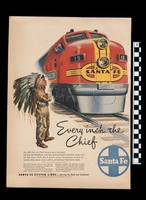 Advertising art This is an advertisement for Santa Fe. It is on a white/cream background and in the middle of the page on the left is a Native American child in traditional clothing. He stands with his arms crossed and looking at a red, silver, and yellow train coming down the tracks which is located on the right side. The train has a man in a hat and blue shirt waving out the window. On each side of the front are the number “19” and the yellow logo with the word “SANTA FE,” are in the front. Below the train it reads “Every Inch the Chief.” Below the child is a small print description followed by “SANTA FE SYSTEM LINES,” in bold black lettering. On the right corner is a circle that is outlined in blue and has a blue cross through it. On the cross reads “Santa Fe.”
Advertising art This is an advertisement for Santa Fe. It is on a white/cream background and in the middle of the page on the left is a Native American child in traditional clothing. He stands with his arms crossed and looking at a red, silver, and yellow train coming down the tracks which is located on the right side. The train has a man in a hat and blue shirt waving out the window. On each side of the front are the number “19” and the yellow logo with the word “SANTA FE,” are in the front. Below the train it reads “Every Inch the Chief.” Below the child is a small print description followed by “SANTA FE SYSTEM LINES,” in bold black lettering. On the right corner is a circle that is outlined in blue and has a blue cross through it. On the cross reads “Santa Fe.” -
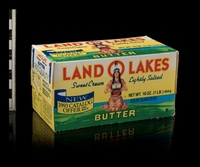 Item Packaging Object is a rectangle box with design on the top and the front that repeat. The design is the words “LAND O LAKES” at the top in a red/orange with a yellow outline and with a white background. The “O” is larger and acts as an halo for the Native American woman’s head and headdressing. The woman is kneeling and wearing traditional clothing while holding up an offering of the product. She is on a grassy green area and blue water followed by a yellow sky are behind her. Below the logo reads “Sweet Cream” on the left and “Lightly Salted” on the right. The left side has a dark blue and yellow ribbon with the word “NEW” in white on the blue section and “1993 CATALOG/OFFER SEE BACK” in blue on the yellow. To the right of the woman are the words “NET WT. 16 OZ. (1.LB) 454 g/ FOUR QUARTERS.” Below the woman is the word “BUTTER,” in yellow. The letter “K”is on the far right corner. The short side of the packaging appears to have the logo on a white background and the words “BUTTER/ Finest Quality” in blue. A blue large number “1” is on the left and right side. More text follows with a yellow background.
Item Packaging Object is a rectangle box with design on the top and the front that repeat. The design is the words “LAND O LAKES” at the top in a red/orange with a yellow outline and with a white background. The “O” is larger and acts as an halo for the Native American woman’s head and headdressing. The woman is kneeling and wearing traditional clothing while holding up an offering of the product. She is on a grassy green area and blue water followed by a yellow sky are behind her. Below the logo reads “Sweet Cream” on the left and “Lightly Salted” on the right. The left side has a dark blue and yellow ribbon with the word “NEW” in white on the blue section and “1993 CATALOG/OFFER SEE BACK” in blue on the yellow. To the right of the woman are the words “NET WT. 16 OZ. (1.LB) 454 g/ FOUR QUARTERS.” Below the woman is the word “BUTTER,” in yellow. The letter “K”is on the far right corner. The short side of the packaging appears to have the logo on a white background and the words “BUTTER/ Finest Quality” in blue. A blue large number “1” is on the left and right side. More text follows with a yellow background. -
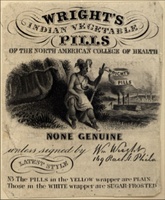 Wright's Indian Vegetable Pills This object is a newspaper advertisement for Wright’s Indian Vegetable Pills. It is on a sepa colored background with black and gray ink print. On the top corner are the name of the product with calligraphy design. Below it reads “OF THE NORTH AMERICAN COLLEGE OF HEALTH” A Native American man in traditional clothing sits on a tree and holds a staff with a ribbon that reads “WRIGHT’S PILLS.” In the background on the right are buildings. Below reads “NONE GENUINE.” In a cursive print on the right it states “unless signed by,” with a signature. On the left bottom section “LATEST STYLE” follows with calligraphy design and the last two lines on the paper state that “The PILLS in the YELLOW wrapper PLAIN/ Those in the WHITE wrapper are SUGAR-FROSTED.”
Wright's Indian Vegetable Pills This object is a newspaper advertisement for Wright’s Indian Vegetable Pills. It is on a sepa colored background with black and gray ink print. On the top corner are the name of the product with calligraphy design. Below it reads “OF THE NORTH AMERICAN COLLEGE OF HEALTH” A Native American man in traditional clothing sits on a tree and holds a staff with a ribbon that reads “WRIGHT’S PILLS.” In the background on the right are buildings. Below reads “NONE GENUINE.” In a cursive print on the right it states “unless signed by,” with a signature. On the left bottom section “LATEST STYLE” follows with calligraphy design and the last two lines on the paper state that “The PILLS in the YELLOW wrapper PLAIN/ Those in the WHITE wrapper are SUGAR-FROSTED.” -
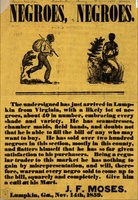 Negroes, Negroes This is a black ink print on yellow paper advertisement for the sale of Black slaves. The top reads “NEGROES, NEGROES.” Below is a walking Black male in pants and shirt with a sack tied to a stick and hanging from his back. On the right side is a Black woman sitting with a plant next to her and a sack in her hand. The images are separated from the text below by two black lines. The text is in bold and explains that J. F. Moses has arrived in “Lumpkin from Virginia, with a likely lot of negroes, about 40 in number, embracing every shade and variety.” The piece goes on to list different types of professions they hold “seamstresses, chamber maids, field hands,” and that he has sold over two hundred slaves. Towards the bottom right reads “J.F. MOSES.,” and below starting at the left, “Lumpkin, GA., Nov. 14th 1859.”
Negroes, Negroes This is a black ink print on yellow paper advertisement for the sale of Black slaves. The top reads “NEGROES, NEGROES.” Below is a walking Black male in pants and shirt with a sack tied to a stick and hanging from his back. On the right side is a Black woman sitting with a plant next to her and a sack in her hand. The images are separated from the text below by two black lines. The text is in bold and explains that J. F. Moses has arrived in “Lumpkin from Virginia, with a likely lot of negroes, about 40 in number, embracing every shade and variety.” The piece goes on to list different types of professions they hold “seamstresses, chamber maids, field hands,” and that he has sold over two hundred slaves. Towards the bottom right reads “J.F. MOSES.,” and below starting at the left, “Lumpkin, GA., Nov. 14th 1859.” -
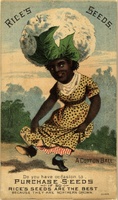 Rice's Seeds This item is an advertisement for rice seeds. The background is a blue and white sky with trees. In the foreground on a dirt area is a dancing Black woman. She wears a yellow dress with black dots on it and a red and white stripe under the layer. There is a white scarf around her neck and she has blue stockings and black shoes. Her hair is replaced with an enlarged cotton ball with a green leaf in the front. Above the cotton ball reads “RICE’S” on the left and “SEEDS,” on the right. By her foot reads “A COTTON BALL.” At the bottom is written “Do you have occasion to/ PURCHASE SEEDS/IF SO/RICE’S SEEDS ARE THE BEST/ BECAUSE THEY ARE NORTHERN GROWN.”
Rice's Seeds This item is an advertisement for rice seeds. The background is a blue and white sky with trees. In the foreground on a dirt area is a dancing Black woman. She wears a yellow dress with black dots on it and a red and white stripe under the layer. There is a white scarf around her neck and she has blue stockings and black shoes. Her hair is replaced with an enlarged cotton ball with a green leaf in the front. Above the cotton ball reads “RICE’S” on the left and “SEEDS,” on the right. By her foot reads “A COTTON BALL.” At the bottom is written “Do you have occasion to/ PURCHASE SEEDS/IF SO/RICE’S SEEDS ARE THE BEST/ BECAUSE THEY ARE NORTHERN GROWN.” -
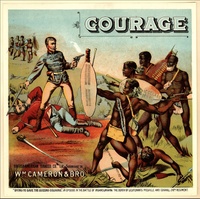 Courage This piece is an advertisement that has a white border. The image is in color and begins with a light blue sky. On the far top corner are indigenous people in war attire on a grassy area. Further front, in front of rocks is a White soldier fully clothed in a blue coat, tan pants, and brown boots, and with a gun in one hand and a sword in the other. He stands above a fellow injured comrade in a red coat, blue pants, and gray boots. In front of them are brown indigenous men who are nude with only a small cloth around their waist. They appear to be of African descent and carry shields and spears. One is on the ground injured. On the top right section reads the word “COURAGE.” On the bottom left hand side in black reads “BRITISH AMERICAN TOBACCO CO. Ltd. Successor to/ Wm CAMERON & BRO./ PETERBURG, VA..” On the white border at the bottom reads “DYING TO SAVE THE QUEENS COLOURS AN EPISODE IN THE BATTLE OF INSANDLWHANA THE DEATH OF LIEUTENANTS MELVILLE AND COGHILL 24th REGIMENT.”
Courage This piece is an advertisement that has a white border. The image is in color and begins with a light blue sky. On the far top corner are indigenous people in war attire on a grassy area. Further front, in front of rocks is a White soldier fully clothed in a blue coat, tan pants, and brown boots, and with a gun in one hand and a sword in the other. He stands above a fellow injured comrade in a red coat, blue pants, and gray boots. In front of them are brown indigenous men who are nude with only a small cloth around their waist. They appear to be of African descent and carry shields and spears. One is on the ground injured. On the top right section reads the word “COURAGE.” On the bottom left hand side in black reads “BRITISH AMERICAN TOBACCO CO. Ltd. Successor to/ Wm CAMERON & BRO./ PETERBURG, VA..” On the white border at the bottom reads “DYING TO SAVE THE QUEENS COLOURS AN EPISODE IN THE BATTLE OF INSANDLWHANA THE DEATH OF LIEUTENANTS MELVILLE AND COGHILL 24th REGIMENT.” -
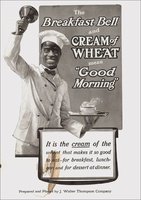 The Breakfast Bell This is a black and white advertisement for Cream of Wheat hot cereal. The image is of a smiling African American man in a striped suit with a bow tie. He wears a chefs hat and in his left hand he is ringing a bell and in his right hand he holds a hot steaming bowl with a spoon inside. Behind him on a gray background reads the words “The/ Breakfast Bell/ and /Cream of /Wheat/ mean/ “Good/ Morning.” Underneath, on a sign, reads “It is the cream of the/ wheat that makes it so good/ to eat-for breakfast, lunch-/eon and for dessert at dinner.” At the bottom of the page “Prepared and Placed by J.Walter Thompson Company” appears.
The Breakfast Bell This is a black and white advertisement for Cream of Wheat hot cereal. The image is of a smiling African American man in a striped suit with a bow tie. He wears a chefs hat and in his left hand he is ringing a bell and in his right hand he holds a hot steaming bowl with a spoon inside. Behind him on a gray background reads the words “The/ Breakfast Bell/ and /Cream of /Wheat/ mean/ “Good/ Morning.” Underneath, on a sign, reads “It is the cream of the/ wheat that makes it so good/ to eat-for breakfast, lunch-/eon and for dessert at dinner.” At the bottom of the page “Prepared and Placed by J.Walter Thompson Company” appears. -
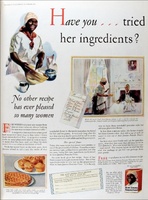 Aunt Jemima's Pancakes This is an Aunt Jemima advertisement. The top left hand corner reads “McCALL’S MAGAZINE OCTOBER 1927.” On the left hand side is a African American woman presented as a mammy. She wears a scarf on her head, a red scarf tired around her shoulders, a white dress and a white apron. Her sleeves are rolled up and she smiles as she mixes batter in a bowl. On the left is a pitcher and on the right is a jar and a package of mix. At the top reads “Have you… tried her ingredients?” with the letter H in red. Below the wording is a painting of the Black woman serving an older White man who sits at a large table in front of a fireplace. A list of handwritten ingredients on paper is drawn to sit on top of the left corner of the painting. Underneath the image of the woman mixing are the words “No other recipe has ever pleased so many women.” Three columns of text are found nearly halfway down the page. Below each column is an image. The first is a painting of waffles and biscuits on a plate. The next image is a mail in for an order of the mix. The final image is a picture of Aunt Jemima on a red box that reads “AUNT JEMIMA PANCAKE FLOUR.”
Aunt Jemima's Pancakes This is an Aunt Jemima advertisement. The top left hand corner reads “McCALL’S MAGAZINE OCTOBER 1927.” On the left hand side is a African American woman presented as a mammy. She wears a scarf on her head, a red scarf tired around her shoulders, a white dress and a white apron. Her sleeves are rolled up and she smiles as she mixes batter in a bowl. On the left is a pitcher and on the right is a jar and a package of mix. At the top reads “Have you… tried her ingredients?” with the letter H in red. Below the wording is a painting of the Black woman serving an older White man who sits at a large table in front of a fireplace. A list of handwritten ingredients on paper is drawn to sit on top of the left corner of the painting. Underneath the image of the woman mixing are the words “No other recipe has ever pleased so many women.” Three columns of text are found nearly halfway down the page. Below each column is an image. The first is a painting of waffles and biscuits on a plate. The next image is a mail in for an order of the mix. The final image is a picture of Aunt Jemima on a red box that reads “AUNT JEMIMA PANCAKE FLOUR.” -
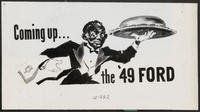 Coming Up...the '49 Ford. This item is a black and white draft sketch of a black butler in a black suit. He has a cloth on his right arm and in the left hand, which is raised, there is a silver platter that is covered. On the left side near the top are the words “Coming up…” and on the bottom right follows “the ‘49 FORD.”
Coming Up...the '49 Ford. This item is a black and white draft sketch of a black butler in a black suit. He has a cloth on his right arm and in the left hand, which is raised, there is a silver platter that is covered. On the left side near the top are the words “Coming up…” and on the bottom right follows “the ‘49 FORD.” -
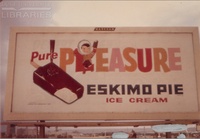 Pure Pleasure The billboard is covering a previous advertisement that is slightly seen, but unreadable, underneath the white background. The words “Pure” are in red, above a vanilla ice cream bar. The word “PLEASURE” is written with each letter being a different color or orange red and pink. An Inuit child in traditional clothing sits on the letter L with an ice cream in hand. Below in black is “ESKIMO PIE” and below that in smaller red font is “ICE CREAM” On the billboard frame, on a black label is the word “MARKHAM,” written in yellow.
Pure Pleasure The billboard is covering a previous advertisement that is slightly seen, but unreadable, underneath the white background. The words “Pure” are in red, above a vanilla ice cream bar. The word “PLEASURE” is written with each letter being a different color or orange red and pink. An Inuit child in traditional clothing sits on the letter L with an ice cream in hand. Below in black is “ESKIMO PIE” and below that in smaller red font is “ICE CREAM” On the billboard frame, on a black label is the word “MARKHAM,” written in yellow. -
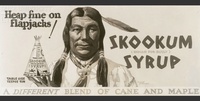 Heap Fine on Flapjacks! A Different Blend of Cane and Maple Description:This piece is a sepia colored billboard. The image of a Native American in traditional dress is drawn. He holds a teepee jar with images of a person on a horse hunting an animal and a moon and sun at the top. On the top right of the billboard it reads “Heap fine on flapjacks!” and below it, next to the teepee it reads “TABLE SIZE TEEPEE TIN” The words “SKOOKUM SYRUP/<INDIAN FOR BULLY>/ SYRUP” are found on the tin jar and on the right side of the board in the center. The words “A DIFFERENT BLEND OF CANE AND MAPLE” are printed across the bottom of the billboard.
Heap Fine on Flapjacks! A Different Blend of Cane and Maple Description:This piece is a sepia colored billboard. The image of a Native American in traditional dress is drawn. He holds a teepee jar with images of a person on a horse hunting an animal and a moon and sun at the top. On the top right of the billboard it reads “Heap fine on flapjacks!” and below it, next to the teepee it reads “TABLE SIZE TEEPEE TIN” The words “SKOOKUM SYRUP/<INDIAN FOR BULLY>/ SYRUP” are found on the tin jar and on the right side of the board in the center. The words “A DIFFERENT BLEND OF CANE AND MAPLE” are printed across the bottom of the billboard. -
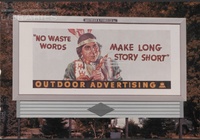 "No Waste Words Make Long Story Short" Outdoor Advertising This item is an outdoor billboard with an image of a Native American male in traditional clothing. The background is a light gray that is outlined with a white border. In blood red the words “NO WASTE WORDS,” on the right and on the left “MAKE LONG STORY SHORT.” Underneath the image, going across the bottom are the words “OUTDOOR ADVERTISING,” in orange and on a black background. The symbol of the company follows in orange. On the frame of the billboard is a black label with “WHITMIER & FERRIS CO. Inc.,” printed in white.
"No Waste Words Make Long Story Short" Outdoor Advertising This item is an outdoor billboard with an image of a Native American male in traditional clothing. The background is a light gray that is outlined with a white border. In blood red the words “NO WASTE WORDS,” on the right and on the left “MAKE LONG STORY SHORT.” Underneath the image, going across the bottom are the words “OUTDOOR ADVERTISING,” in orange and on a black background. The symbol of the company follows in orange. On the frame of the billboard is a black label with “WHITMIER & FERRIS CO. Inc.,” printed in white. -
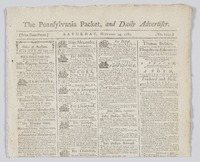 The Pennsylvania Packet, and Daily Advertiser No. 2747 This is a four-page newspaper from November 24, 1787. It is an edition of the Pennsylvania Packet, and Daily Advertiser that is yellowed paper with black ink and edges torn in many places and many creases. Several advertisements are on the front and back with articles and additional advertisements in the middle. One of the advertisements includes the sale of two enslaved people and is found on the front page at the bottom left corner. The first one is for the sale of a 29-year- old unidentified enslaved male. The second advertisement is for the sale of an unidentified enslaved female. The third column on the front page has an advertisement for a ten-dollar reward on information on a runaway slave named Will from Buck County, Pennsylvania and belonging to Mr. Alexander Allair. The advertisement describes Will’s height and physical ailments along with his language proficiency.
The Pennsylvania Packet, and Daily Advertiser No. 2747 This is a four-page newspaper from November 24, 1787. It is an edition of the Pennsylvania Packet, and Daily Advertiser that is yellowed paper with black ink and edges torn in many places and many creases. Several advertisements are on the front and back with articles and additional advertisements in the middle. One of the advertisements includes the sale of two enslaved people and is found on the front page at the bottom left corner. The first one is for the sale of a 29-year- old unidentified enslaved male. The second advertisement is for the sale of an unidentified enslaved female. The third column on the front page has an advertisement for a ten-dollar reward on information on a runaway slave named Will from Buck County, Pennsylvania and belonging to Mr. Alexander Allair. The advertisement describes Will’s height and physical ailments along with his language proficiency. -
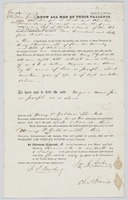 Bill of Sale with Two Transactions for an Enslaved Man Named Joe or Joseph This item is a printed and handwritten single sheet document of a bill of sale for an enslaved man known as “Joseph or Joe.” The front side contains a transaction on July 16, 1844 in which Joseph L. Lock and Charles Davis in Savannah, Georgia sold “Negro man Joe or Joseph as a slave,” for $465 to Henry P. Goldsmith of Chambers County, Alabama. Joe is described as 19 and of “bright mulatto colour.” The back of the document contains another transaction, dated August 26, 1844 that transferred Joe from Goldsmith to James Akins of Chambers County, Alabama for “value received.” G. S. Harding acted as witness to both sales.
Bill of Sale with Two Transactions for an Enslaved Man Named Joe or Joseph This item is a printed and handwritten single sheet document of a bill of sale for an enslaved man known as “Joseph or Joe.” The front side contains a transaction on July 16, 1844 in which Joseph L. Lock and Charles Davis in Savannah, Georgia sold “Negro man Joe or Joseph as a slave,” for $465 to Henry P. Goldsmith of Chambers County, Alabama. Joe is described as 19 and of “bright mulatto colour.” The back of the document contains another transaction, dated August 26, 1844 that transferred Joe from Goldsmith to James Akins of Chambers County, Alabama for “value received.” G. S. Harding acted as witness to both sales. -
 The Slave Market, Atlanta, Ga. First image is of a sepia colored stereograph on yellow cardstock. The side by side photographs contain one human figure in a hat and with a rifle, leaning against a building that is flanked by two other buildings. The building on the left has a sign that reads “F. GEUTEBRUCK.” The center building has a sign on the upper floor that reads “CHINA GLASS / & / QUEENSWARE’ and “AUCTION & NEGRO SALES” on the lower level. Also on the lower level is a sign in a window that reads “LAMP, PINE / & / KEROSENE OILS.” The building on the right has a sign that reads “ATLANTA /CIGAR/ MANUFACTORY.” The rest of the road is clear and a few buildings continue down after the one on the right. Printed vertically in black ink on the yellow card stock reads “PHOTOGRAPHIC HISTORY,” on the left and “THE WAR FOR THE UNION,” on the right. On the back is a blue piece of paper with black text that reads “WAR VIEWS./The slave Market, Atlanta, Ga./No.3608/Published by E & H. T. Anthony & Co.,/American and foreign Stereoscopic Emporium, 501 Broadway, New-York.” The blue paper also contains an Internal Revenue Two Cent Proprietary stamp with the image of George Washington.
The Slave Market, Atlanta, Ga. First image is of a sepia colored stereograph on yellow cardstock. The side by side photographs contain one human figure in a hat and with a rifle, leaning against a building that is flanked by two other buildings. The building on the left has a sign that reads “F. GEUTEBRUCK.” The center building has a sign on the upper floor that reads “CHINA GLASS / & / QUEENSWARE’ and “AUCTION & NEGRO SALES” on the lower level. Also on the lower level is a sign in a window that reads “LAMP, PINE / & / KEROSENE OILS.” The building on the right has a sign that reads “ATLANTA /CIGAR/ MANUFACTORY.” The rest of the road is clear and a few buildings continue down after the one on the right. Printed vertically in black ink on the yellow card stock reads “PHOTOGRAPHIC HISTORY,” on the left and “THE WAR FOR THE UNION,” on the right. On the back is a blue piece of paper with black text that reads “WAR VIEWS./The slave Market, Atlanta, Ga./No.3608/Published by E & H. T. Anthony & Co.,/American and foreign Stereoscopic Emporium, 501 Broadway, New-York.” The blue paper also contains an Internal Revenue Two Cent Proprietary stamp with the image of George Washington.